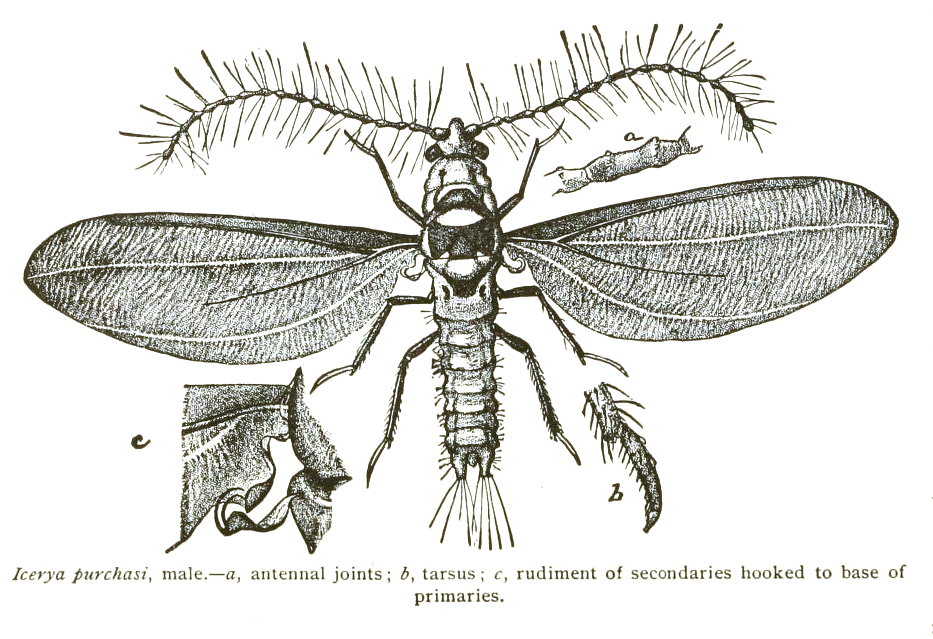|
Monophlebidae
Monophlebidae is a family of scale insects commonly known as the giant scales or monophlebids. They occur in most parts of the world but more genera are found in the tropics than elsewhere.UDSA Agricultural Research Service The cottony cushion scale, '' Icerya purchasi'', is a serious commercial pest on many families of woody plants, including ''''. It has spread worldwide from Australia. Taxonomy At one time, Monophlebidae was considered to be a subfamily of |
Margarodidae
The Margarodidae (illegitimately as Margodidae) or ground pearls are a family of scale insects within the superfamily Coccoidea. Members of the family include the Polish cochineal and Armenian cochineal (genus ''Porphyrophora'') and the original ground pearl genus, ''Margarodes''. Beginning in 1880, a number of distinct subfamilies were recognized, with the giant coccids (the Monophlebidae) being the first.Maskell recognized the Monophlebidae as a separate family that year, Although Maskell proposed a new family, many continued to regard the monophlebids as a mere subfamily for many years, and the Margarodidae classification continued to be polyphyletic through the 20th Century. Since then, taking the advice of Koteja several subfamilies and tribes have been elevated into their own families such as Matsucoccidae and Xylococcidae. The pared-down family of Margarodidae (Margarodidae ''sensu stricto'' or Margarodidae s. s.) is monophyletic. List of genera * '' Dimargarodes'' Silv ... [...More Info...] [...Related Items...] OR: [Wikipedia] [Google] [Baidu] |
Icerya Seychellarum
''Icerya'' is a genus of scale insects in the family Monophlebidae. It is named after physician-naturalist Dr. Edmond Icery of British Mauritius. Hermaphroditism Hermaphroditism is extremely rare in the insect world despite the comparatively common nature of this condition in the crustaceans. Several species of ''Icerya'', including the pestiferous cottony-cushion scale, ''I. purchasi'', are known to be hermaphrodites that reproduce by self-fertilising. Occasionally males are produced from unfertilised eggs, but generally individuals are monoecious with a female-like nature but possessing an ovotestis (a part-testis, part-ovary organ) and sperm is transmitted ovarially from the female to her young. This hermaphroditic sexual self-sufficiency, where a single individual can populate new territory, has contributed to the invasive spread of the cottony-cushion scale insect away from its native Australia.The Insects An outline of Entomology, Gullan & Cranston, Wiley-Blackwell 2001 L ... [...More Info...] [...Related Items...] OR: [Wikipedia] [Google] [Baidu] |
Scale Insect
Scale insects are small insects of the order Hemiptera, suborder Sternorrhyncha. Of dramatically variable appearance and extreme sexual dimorphism, they comprise the infraorder Coccomorpha which is considered a more convenient grouping than the superfamily Coccoidea due to taxonomic uncertainties. Adult females typically have soft bodies and no limbs, and are concealed underneath domed scales, extruding quantities of wax for protection. Some species are hermaphroditic, with a combined ovotestis instead of separate ovaries and testes. Males, in the species where they occur, have legs and sometimes wings, and resemble small flies. Scale insects are herbivores, piercing plant tissues with their mouthparts and remaining in one place, feeding on sap. The excess fluid they imbibe is secreted as honeydew on which sooty mold tends to grow. The insects often have a mutualistic relationship with ants, which feed on the honeydew and protect them from predators. There are about 8,000 de ... [...More Info...] [...Related Items...] OR: [Wikipedia] [Google] [Baidu] |
Icerya
''Icerya'' is a genus of scale insects in the family Monophlebidae. It is named after physician-naturalist Dr. Edmond Icery of British Mauritius. Hermaphroditism Hermaphroditism is extremely rare in the insect world despite the comparatively common nature of this condition in the crustaceans. Several species of ''Icerya'', including the pestiferous cottony-cushion scale, ''I. purchasi'', are known to be hermaphrodites that reproduce by self-fertilising. Occasionally males are produced from unfertilised eggs, but generally individuals are monoecious with a female-like nature but possessing an ovotestis (a part-testis, part-ovary organ) and sperm is transmitted ovarially from the female to her young. This hermaphroditic sexual self-sufficiency, where a single individual can populate new territory, has contributed to the invasive spread of the cottony-cushion scale insect away from its native Australia.The Insects An outline of Entomology, Gullan & Cranston, Wiley-Blackwell 2001 ... [...More Info...] [...Related Items...] OR: [Wikipedia] [Google] [Baidu] |
Icerya Purchasi
''Icerya purchasi'' (common name: cottony cushion scale) is a scale insect that feeds on more than 80 families of woody plants, most notably on ''Citrus'' and ''Pittosporum''. Originally described in 1878 from specimens collected in New Zealand as pests of kangaroo acacia and named by W.M. Maskell "after the Rev. Dr. Purchas who, ebelieve first found it". It is now found worldwide where citrus crops are grown. The cottony cushion scale originates from Australia. Life cycle This scale infests twigs and branches. The mature hermaphrodite is oval in shape, reddish-brown with black hairs, 5 mm long. When mature, the insect remains stationary, attaches itself to the plant by waxy secretions, and produces a white egg sac in grooves, by extrusion, in the body which encases hundreds of red eggs. The egg sac will grow to be two to three times as long as the body. Newly hatched nymphs are the primary dispersal stage, with dispersion known to occur by wind and by crawling. Early st ... [...More Info...] [...Related Items...] OR: [Wikipedia] [Google] [Baidu] |
Drosicha
''Drosicha'' is a genus of true bugs belonging to the family Margarodidae. The species of this genus are found in Eurasia. Species: *''Drosicha afganica'' *''Drosicha burmeisteri'' *''Drosicha contrahens'' *''Drosicha corpulenta'' *''Drosicha dalbergiae'' *''Drosicha frauenfeldi'' *''Drosicha howardi'' *''Drosicha jujubae'' *''Drosicha koreiensis'' *''Drosicha leachii'' *''Drosicha littorea'' *''Drosicha malaysiensis'' *''Drosicha mangiferae'' *''Drosicha maskelli'' *''Drosicha minor'' *''Drosicha palavanica'' *''Drosicha philippinensis'' *''Drosicha pinicola'' *''Drosicha quadricaudata'' *''Drosicha saundersii'' *''Drosicha stebbingii'' *''Drosicha sumatrensis'' *''Drosicha townsendi'' *''Drosicha turkestanica'' *''Drosicha variegata ''Drosicha'' is a genus of true bugs belonging to the family Margarodidae The Margarodidae (illegitimately as Margodidae) or ground pearls are a family of scale insects within the superfamily Coccoidea. Members of the f ... [...More Info...] [...Related Items...] OR: [Wikipedia] [Google] [Baidu] |

